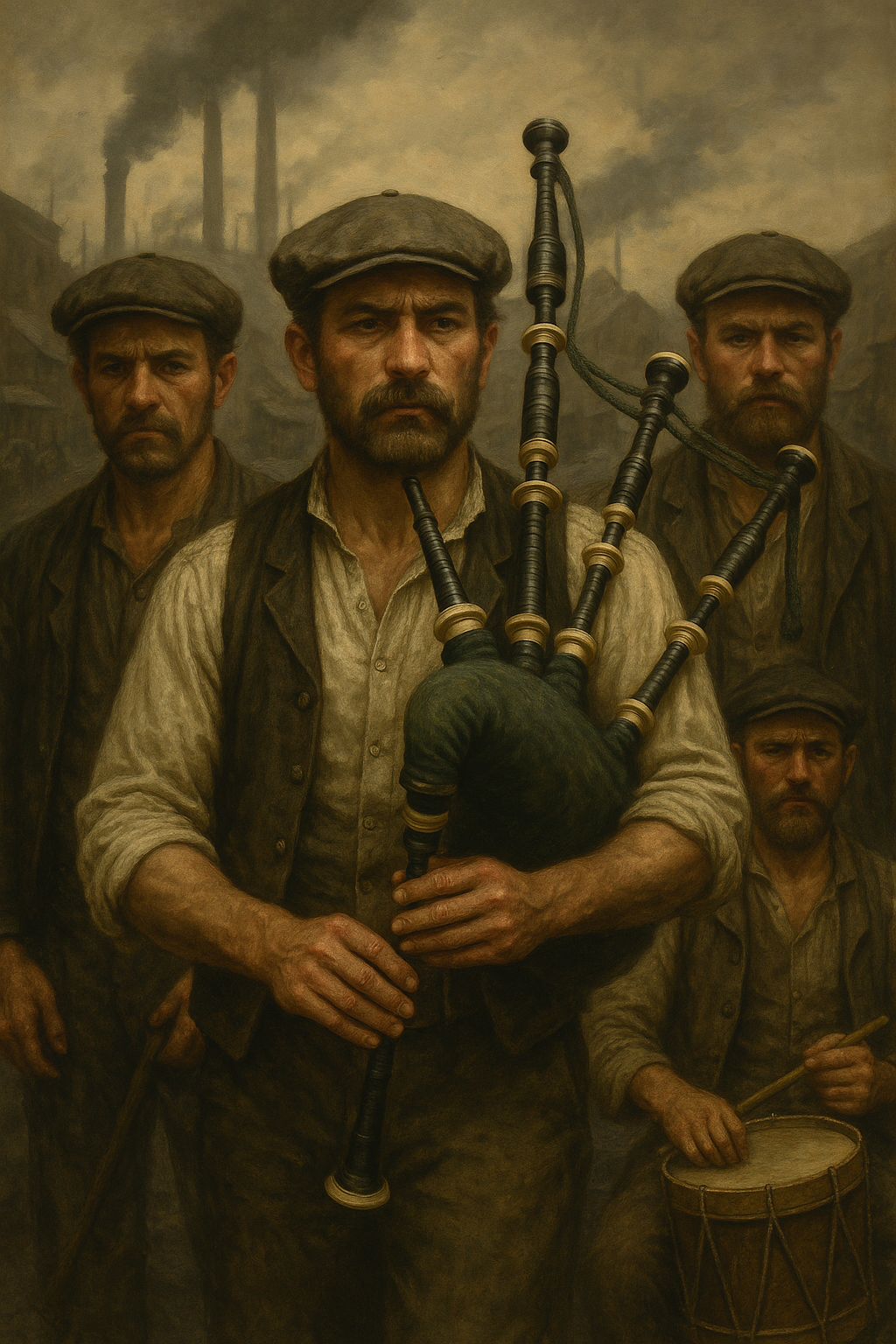
The Molly Maguire Pipers
Pipes of Defiance: The Great Irish Bagpipes and the Forgotten Soundtrack of the Molly Maguire's
By [John Hunt Sr.]
In the mists of Irish and Irish-American history, the secretive vigilante group known as the Molly Maguires has long stood as a symbol of resistance — Irish miners fighting exploitation in the coalfields of 19th-century Pennsylvania. But behind the headlines of murder trials, Pinkerton agents, and gallows justice lies a deeper and older tradition: the sound of the Píob Mór na hÉireann — the Great Irish Bagpipes, also known as the Irish Warpipes.
While academic records on the piping traditions of the Molly Maguires are scarce, strong oral history and folkloric evidence point to a living connection between the militant tenant-rights movements in Ireland and the Irish-American resistance embodied by the Mollies. This article explores the cultural and historical links between the Fenian-era piping tradition and the Molly Maguires — asserting that these rebels carried not just rifles and rosaries, but the long-respected music of defiance.
Pipers and Patriots: A Tradition of Resistance
The Great Irish Bagpipes (often conflated with their Highland cousins) have long been tied to Irish nationalism. In Ireland, pipers ( of the mouth blown Irish Bagpioes ) were frequently associated with rural agitation movements like the Whiteboys, Ribbonmen, Rockites, and later the Land League — all of which opposed landlord injustice and British domination. These groups often used music to announce meetings, lead marches, or stir courage before action.
Throughout the 18th and 19th centuries, pipers accompanied everything from fairs to funerals to armed rebellion. In many communities, the piper was not just a musician — he was a symbol of collective identity and a spiritual comrade in struggle.
By the mid-1800s, the Fenian Brotherhood — a transatlantic Irish republican movement — carried that tradition forward. It is well-documented that many Fenians were pipers, and in turn, many pipers were Fenians. In agrarian societies, these roles were often interchangeable: the piper doubled as the agitator, the recruiter, or the signalman.
The Molly Maguires: From Wexford to West Limerick to the Mines
The Molly Maguires, active in the Pennsylvania coalfields from the 1860s to the 1870s, were widely believed to be an American extension of the Fenians or at least deeply infused with Fenian ideology. Most of their members were Irish immigrants not just from Ulster and Leinster, but also from South and West Munster, including West Limerick.
Indeed, in Newcastle West, County Limerick, this authors home town, a buíon (band) of pipers and drummers called “ The Molly Maguires “ operated in the town between 1895 and 1910, without the formal military-style bass and tenor drumming found in modern military or Irish and Scottish pipe bands. ( The addition of a Bass Drum and Tenors occurred after Irish Pipers saw Turkish Military Bands while in Europe ), This group carried on the same grassroots Irish musical tradition deeply interwoven with community, land rights, and local pride. Their presence reflects a living continuity of rural nationalist piping, rooted in earlier struggles.

Kehoe and the Piper Named “ Delee “
John “Black Jack” Kehoe, the so-called “King of the Mollies,” hailed from County Wexford, another stronghold of Irish rebellion since 1798. According to family lore and oral history, Kehoe’s father was both a rebel in the early 1800’s ( likely with the Whiteboys ) and a traditional marching bagpiper, Kehoe was continuing a tradition from his native Ireland to the coalfields of Pennsylvania.
Equally intriguing is the story passed down by an elderly Wexford piper who played with the O’Hanrahan Warpipe Band — now sadly passed on — that Kehoe’s right-hand man was also a piper.
While the full name is lost to time, the name “ Delee “ ( possibly Mick Jr. / Micilín Delee, as Gaeilge - in Irish Gaelic ) remains as a trace. It is a tantalizing hint of the cultural network surrounding Kehoe and his inner circle: men who were not only militants, but also musicians. The piper named Delee, if he existed as remembered, would have been one of many who carried the tunes of rebellion into exile.
Folklore Where Paper Fails
The absence of documented bagpiping among the Mollies does not negate its fact in history — rather, it reflects a broader silence in the official historical record, which often overlooks working-class culture, oral history, and musical tradition. Indeed, there is several mentions of the Irish playing mouth blown Irish pipes with fiddlers in America at this time. One famous reference in the publication “ Them Poor Lads In Pennsylvania “ where the loud music and dance of the Irish using the Piob Mor is quoted.
Just as the Uilleann pipe , and much earlier Píob Mór Bagpipe traditions of the Irish Traveler Community and rural musicians were sidelined for decades, the piping of Fenian and Molly Maguire-linked communities may have been heard but not written down.
Folklore and familial memory, however, remain resilient. Across Ireland and the Irish-American northeast, stories of pipers accompanying Fenian meetings, land protests, or wakes for executed comrades persist. These pipes were not for dance halls — they were for marches, for laments, and for rising up.
Bagpipes as Cultural Resistance
The Molly Maguires were more than miners — they were cultural carriers of Ireland’s longest-standing symbols of defiance. Just as their ancestors played the Great Irish Bagpipes through rebellions in 1798 and 1848, it is highly plausible that these instruments traveled with them across the Atlantic.
In many ways, the Irish Warpipes were banned or discouraged in both British-controlled Ireland and elite American society — not because of their volume, but because of what they represented: rebellion, unity, and pride.
Conclusion: Listening to the Past
It’s time to reframe the legacy of the Molly Maguires through a cultural lens. Not just as violent agitators or labor martyrs, but as inheritors of a rich Irish folk tradition where music, especially bagpipes, was inseparable from political identity.
Whether or not the courts of the 1870s documented it, the spirit of the pipes marched alongside the Mollies — echoing from the hills of places like Wexford and Limerick to the coal mines of Pennsylvania.
In the words of one old rebel tune:
“You may break the harp and chain the tongue,
But the pipes will play till the last bell’s rung.”
🗂 Suggested Reading & Listening:
- Making Sense of the Molly Maguires – Kevin Kenny
- The Fenian Song Tradition and the Music of Rebellion – Pádraig Ó Cearbhaill
- The Great Irish Warpipes: A Hidden Tradition – [Your Upcoming Book or Article]
- Oral History collections from Schuylkill County, Wexford, and West Limerick
- Traditional rebel piping tunes: The Bold Fenian Men, Rising of the Moon, Wrap the Green Flag around me, Kelly the Boy from Killane, The Wearing of The Green

Leave a comment